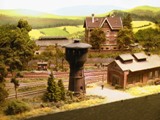Don't Get Too Complicated

When it comes to track layout and design there are some details you might want to note as a beginner. Getting the balance right between a design that is not too simple and one that is way beyond your skills to start with can be difficult. Starting with a smaller scale, such as HO scale or N gauge trains, is often a good idea. Here are some pitfalls to avoid.
Don’t create too many ‘turnouts’ these are branch lines or sidings. A single siding to a goods yard with perhaps two branches to it will provide enough challenge and interest to begin with. You can always add to the design later.
Avoid complex curving lines - an oval is a good basic design to start with. Don’t include complex ‘S’ bends on your first attempt, technically these are difficult to lay and can cause problems when running trains if you don’t get them right. Experience with your model and its trains will help you to understand how the rolling stock and the tracks interact and with time you can use this experience to become more adventurous with your layout.
If you are using an oval design use as large a radius curve as possible. On real railways there are no sharp lefts or rights – if there were there would be many more accidents. A good wide curve will ensure the rolling stock moves smoothly on the tracks and avoid derailments. This rule is one to stick with throughout your model building career, regardless of how experienced you become.
You can still add variety to your first set by creating branch lines and parallel lines; however always keep these basic rules in mind when adding to your model design.
Don’t create too many ‘turnouts’ these are branch lines or sidings. A single siding to a goods yard with perhaps two branches to it will provide enough challenge and interest to begin with. You can always add to the design later.
Avoid complex curving lines - an oval is a good basic design to start with. Don’t include complex ‘S’ bends on your first attempt, technically these are difficult to lay and can cause problems when running trains if you don’t get them right. Experience with your model and its trains will help you to understand how the rolling stock and the tracks interact and with time you can use this experience to become more adventurous with your layout.
If you are using an oval design use as large a radius curve as possible. On real railways there are no sharp lefts or rights – if there were there would be many more accidents. A good wide curve will ensure the rolling stock moves smoothly on the tracks and avoid derailments. This rule is one to stick with throughout your model building career, regardless of how experienced you become.
You can still add variety to your first set by creating branch lines and parallel lines; however always keep these basic rules in mind when adding to your model design.
